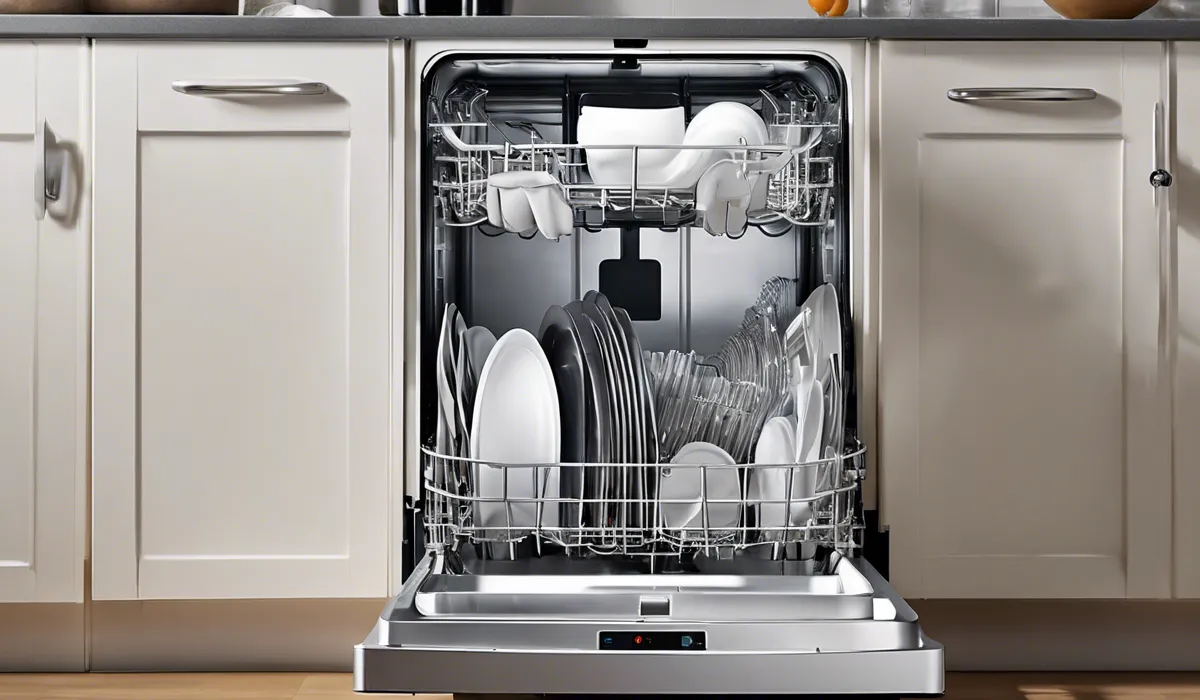How Do Portable Dishwasher Work? Secrets to Spotless Dishes!
Portable dishwashers work by connecting to a faucet for water intake and draining into the sink. They have wheels for easy movement, and use built-in heating elements to warm water and dry dishes after cleaning cycles, similar to built-in models.
Understanding Portable Dishwashers: Functionality and Design

What Are Portable Dishwashers?
Portable dishwashers are compact appliances designed to clean dishes efficiently while offering the convenience of mobility.
Unlike traditional built-in dishwashers, these units can be moved from one location to another, making them ideal for homes with limited space or no dedicated dishwasher spot.
Core Components of Portable Dishwashers
At the heart of any portable dishwasher are several key components that work together to ensure your dishes come out clean.
The water inlet connects to your kitchen faucet to draw fresh water into the machine. A pump then circulates the water, while a heating element warms it to the optimal temperature.
Spray arms rotate and spray the water onto the dishes, and a detergent dispenser releases the cleaning agent at the right moment. Finally, a drainage system expels dirty water into the sink.
Different Designs: Countertop vs. Freestanding
Portable dishwashers come in two primary designs: countertop models and freestanding units.
Countertop models are compact and can sit on your kitchen counter, ideal for small households or apartments.
Freestanding units are larger, resembling traditional dishwashers, but with wheels for easy movement.
Mobility Features: The Importance of Wheels
The inclusion of wheels on portable dishwashers is what truly sets them apart. These wheels facilitate the movement of the unit from storage to the kitchen, allowing you to hook it up to a water source whenever needed.
After the dishes are clean, you can effortlessly roll the dishwasher back to its storage spot.
The Dishwashing Process in Portable Units

Setting Up Your Portable Dishwasher
Before you can wash your dishes, you’ll need to connect your portable dishwasher to a water supply and ensure proper drainage. This typically involves attaching a hose to your kitchen faucet and placing the drainage hose in the sink.
Loading Dishes: Maximizing Space
Efficiently loading dishes into the portable dishwasher is crucial for achieving the best cleaning results. It’s important to arrange plates, cups, and utensils in a way that allows water from the spray arms to reach all surfaces.
Understanding the Cleaning Cycle Phases
Portable dishwashers typically follow four main cycle phases: prewash, wash, rinse, and dry. Each phase plays a specific role in ensuring that your dishes emerge spotless and ready for use.
Heating Water: The Role of the Thermostat
The built-in heating element in your portable dishwasher raises the water temperature to the ideal level for dissolving grease and food residue. A thermostat ensures the temperature remains consistent throughout the wash cycle.
Detergents and Rinse Aids
Choosing the right detergent and using rinse aids can significantly enhance the cleaning power of your portable dishwasher. These products help break down food particles and leave your dishes sparkling clean without water spots.
Water Spraying and Cleaning Efficiency
The spray arms in a portable dishwasher are designed to cover every inch of your dishes with water. The force and pattern of the water spray are crucial for removing food and ensuring thorough cleaning.
Drainage System: Managing Waste Water
After the dishes are clean, the used water needs to be expelled from the dishwasher. The drainage system efficiently removes the dirty water, depositing it into your sink to prevent any mess.
Advantages and Limitations of Portable Dishwashers

Space-Saving Solutions for Compact Living
Portable dishwashers are a boon for small kitchens and apartments where space is at a premium.
Their compact size and ability to be stowed away when not in use make them an excellent choice for maximizing kitchen space.
Mobility and Storage Convenience
The ease of moving and storing portable dishwashers adds a layer of convenience to your daily routine. With no permanent installation required, you can reclaim your kitchen space after each use.
Capacity and Energy Usage: Portable vs. Built-In
When compared with built-in models, portable dishwashers often have a smaller capacity.
However, they can be more energy-efficient due to their size and the fact that they’re only used when needed.
Consumption Considerations: Water and Electricity
It’s important to be mindful of water and electricity usage with portable dishwashers, as these factors can affect your utility bills. Selecting energy-efficient models and running full loads can help minimize consumption.
Maintenance and Cleaning
Regular maintenance and cleaning are essential for keeping your portable dishwasher in top condition.
Simple tasks such as cleaning the filters and checking the spray arms for clogs can prolong the life of your appliance.
Suitability for Various Household Sizes
Whether you live alone or with a small family, portable dishwashers can be a suitable option. They offer the flexibility to handle different amounts of dishes based on your household needs.
FAQs About Portable Dishwashers
How does a portable dishwasher connect to a faucet?
A portable dishwasher typically comes with an adapter that attaches to the faucet, allowing it to draw in water for the wash cycle.
Where does the water drain from a portable dishwasher?
The water from a portable dishwasher drains into the sink through a hose that is attached to the dishwasher.
Do portable dishwashers need to be connected to hot water?
No, portable dishwashers have built-in heating elements to warm the water themselves, so they can be connected to cold water faucets.
How do you move a portable dishwasher?
Portable dishwashers have wheels that allow them to be rolled to and from the kitchen sink or storage area easily.
Do portable dishwashers dry dishes as well?
Yes, most portable dishwashers have a drying cycle that uses a built-in heating element to dry the dishes after cleaning.
Final Thoughts
Portable dishwashers offer the convenience of mobility thanks to their wheels, and function by connecting to a faucet for water supply and draining into a sink.
They incorporate built-in heating elements to heat water for washing and to dry dishes following the cleaning cycles, providing similar performance to their built-in counterparts.





